| Features: Garden wildlife |  |
Cats and Garden Widlife
There is little doubt that predation by domestic cats has a considerable impact on wild animals in and around the garden. An often-quoted figure from research done by the Mammal Society is that cats may kill 275 million animals every year, though other people question the accuracy of this figure and some of the study's methods. Whatever the actual figure, there are many steps that cat owners can take to reduce the threat posed to wildlife by their cats.
How bad is the problem?
I cannot establish exactly how the figure of 275 million animals was calculated. To quote from the published results, "a British population of 9 million cats was estimated to have brought home in the order of 92 (85-100) million prey items in the period of this survey". Given that the period of the survey was April 1st to August 31st, the figure of 92 million extrapolates to 220 million for the entire year. Even the upper figure of 100 million over the course of the survey only extrapolates to 240 million for the year. In addition the survey was conducted during the spring and summer when cats are more likely to catch prey because animals (particularly birds) are breeding then: young animals present a much easier target to cats than experienced adults. All in all,  the extrapolation to 275 million animals seems questionable at best the extrapolation to 275 million animals seems questionable at best the extrapolation to 275 million animals seems questionable at best. the extrapolation to 275 million animals seems questionable at best.
Regardless of the scientific validity of some of the figures quoted,  it is clear that cats are responsible for a great deal of predation on native wildlife in and around our gardens it is clear that cats are responsible for a great deal of predation on native wildlife in and around our gardens it is clear that cats are responsible for a great deal of predation on native wildlife in and around our gardens. Birds, mammals, reptiles and amphibians (as well as invertebrates like butterflies) all feature amongst the prey taken by them. it is clear that cats are responsible for a great deal of predation on native wildlife in and around our gardens. Birds, mammals, reptiles and amphibians (as well as invertebrates like butterflies) all feature amongst the prey taken by them. 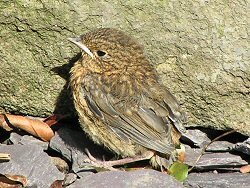 A fledgling robin - typical cat prey. But robins are on the increase in urban areas.
Whatever the actual levels of predation are, whether or not cats actually have a substantive negative effect on native animal populations is another question. More research is required (for example into other causes of death like window strikes) in order to shed more light on this. What is generally agreed is that A fledgling robin - typical cat prey. But robins are on the increase in urban areas.
Whatever the actual levels of predation are, whether or not cats actually have a substantive negative effect on native animal populations is another question. More research is required (for example into other causes of death like window strikes) in order to shed more light on this. What is generally agreed is that  predation by cats is most likely to be a serious problem where their prey species are at risk from other factors predation by cats is most likely to be a serious problem where their prey species are at risk from other factors predation by cats is most likely to be a serious problem where their prey species are at risk from other factors. Although robins (Erithacus rubecula) feature highly on the list of birds taken by cats, their populations in urban areas are actually increasing, so cat predation on robins is not a problem per se. On the other hand, song thrushes (Turdus philomelos) and house sparrows (Passer domesticus) are declining in urban areas (probably due to a number of interacting factors) and predation by cats can only make the problem worse. Likewise cats living in areas adjacent to scarce lowland heaths, which can be home to some of our most endangered reptiles like the sand lizard (Lacerta agilis), could pose a real threat to these species. predation by cats is most likely to be a serious problem where their prey species are at risk from other factors. Although robins (Erithacus rubecula) feature highly on the list of birds taken by cats, their populations in urban areas are actually increasing, so cat predation on robins is not a problem per se. On the other hand, song thrushes (Turdus philomelos) and house sparrows (Passer domesticus) are declining in urban areas (probably due to a number of interacting factors) and predation by cats can only make the problem worse. Likewise cats living in areas adjacent to scarce lowland heaths, which can be home to some of our most endangered reptiles like the sand lizard (Lacerta agilis), could pose a real threat to these species.
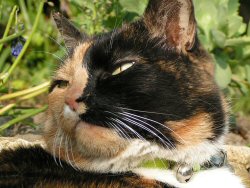 As family pets, cats play an important role in educating children about animals and animal welfare.
In a debate where emotions usually run high and reason sometimes goes out the window, we should all remember that As family pets, cats play an important role in educating children about animals and animal welfare.
In a debate where emotions usually run high and reason sometimes goes out the window, we should all remember that  when cats hunt, they do not do so out of malice; they are simply expressing their innate behaviour as predatory mammals when cats hunt, they do not do so out of malice; they are simply expressing their innate behaviour as predatory mammals when cats hunt, they do not do so out of malice; they are simply expressing their innate behaviour as predatory mammals. We must also accept that it is incumbent on us cat owners to do all we can to minimise the impact of this natural behaviour in an urban or suburban setting where cats are kept in unnaturally high densities. Neither should we forget the less obvious but nevertheless real benefits of pet cats to the natural world: how many children have grown up with an empathy for animals, including wildlife, that was fostered to a great extent by close contact with a pet cat in their formative years? These effects are less easily measured but cannot be dismissed out of hand. when cats hunt, they do not do so out of malice; they are simply expressing their innate behaviour as predatory mammals. We must also accept that it is incumbent on us cat owners to do all we can to minimise the impact of this natural behaviour in an urban or suburban setting where cats are kept in unnaturally high densities. Neither should we forget the less obvious but nevertheless real benefits of pet cats to the natural world: how many children have grown up with an empathy for animals, including wildlife, that was fostered to a great extent by close contact with a pet cat in their formative years? These effects are less easily measured but cannot be dismissed out of hand.
It is clear that not all predation by cats is serious at the population level, but in some cases it undoubtedly is so. In any case,  people who garden for wildlife are not likely to want to see their cats capture and kill any wildlife in the garden people who garden for wildlife are not likely to want to see their cats capture and kill any wildlife in the garden people who garden for wildlife are not likely to want to see their cats capture and kill any wildlife in the garden. Do we have to accept that cats will be cats and turn a blind eye; or is there something we can do about it? Well, as it turns out, there's actually quite a lot that the responsible cat owner can do to keep a happy cat and at the same time make their garden wildlife safer. people who garden for wildlife are not likely to want to see their cats capture and kill any wildlife in the garden. Do we have to accept that cats will be cats and turn a blind eye; or is there something we can do about it? Well, as it turns out, there's actually quite a lot that the responsible cat owner can do to keep a happy cat and at the same time make their garden wildlife safer.
What can we do?
There is no single thing we can do to prevent cats predating our garden wildlife - if there were, we would all be doing it. However, there are a large number of things we can do which each, in their own way, help to reduce the problem. By-and-large, all of the steps we can take fit into one of three categories.
- Steps to reduce the cat's inclination to hunt.
- Steps to reduce the cat's opportunity to hunt.
- Steps to reduce the cat's effectiveness as a hunter.
Reducing inclination- Make sure your cat is neutered.
- Feed and care for your cat well.
- Give your cat toys and plenty of affection.
- Use repellent devices or plants in sensitive areas of the garden.
- Teach your cat that you don't want it to hunt.
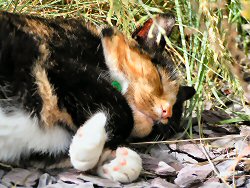 A contented cat is less likely to wander from home and hunt for distraction or out of boredom.
Apart from people who have a serious interest in breeding cats, there is really no good reason to own a cat which is not neutered. Apart from the obvious advantage of reducing the risk of producing unwanted litters and increasing the feral population, A contented cat is less likely to wander from home and hunt for distraction or out of boredom.
Apart from people who have a serious interest in breeding cats, there is really no good reason to own a cat which is not neutered. Apart from the obvious advantage of reducing the risk of producing unwanted litters and increasing the feral population,  neutered cats tend to be healthier and happier, making better family pets and staying closer to home neutered cats tend to be healthier and happier, making better family pets and staying closer to home neutered cats tend to be healthier and happier, making better family pets and staying closer to home. Neutered cats are thought to be less inclined to hunt. Anything you do to take care of your cat's welfare and general happiness, such as providing it with neutered cats tend to be healthier and happier, making better family pets and staying closer to home. Neutered cats are thought to be less inclined to hunt. Anything you do to take care of your cat's welfare and general happiness, such as providing it with  good feeding and plenty of affection, will result in a happier cat that is less inclined to hunt good feeding and plenty of affection, will result in a happier cat that is less inclined to hunt good feeding and plenty of affection, will result in a happier cat that is less inclined to hunt for diversion or because of boredom. good feeding and plenty of affection, will result in a happier cat that is less inclined to hunt for diversion or because of boredom.
If you have particularly sensitive areas of your garden where you wish to reduce the likelihood of your cat (or other people's cats) from wandering, then you can try placing deterrents in those areas. A plant called Coleus canina (sometimes known as 'Pee-off' or 'Scaredy cat'), which purports to repel cats, has recently come onto the market. You could try planting this in sensitive spots. Lemon and orange peel will also deter some cats. Citronella and Renardine are commercially available repellents, but these may deter some wildlife too. Other more hi-tech approaches, like infrared-triggered sonic devices or water sprayers can also be tried, but these tend to be very expensive.
It's hard to curb, by training, an instinct as strong as a cat's desire to hunt, but I have had some success with this. My cat, Clarry, knows very well that I don't like her hunting animals in the garden: if she ever catches anything whilst I'm around, she knows that an unpleasant scene will follow with me chasing her and shouting until she drops the poor animal. Recently in the garden a chaffinch (Fringilla coelebs) was feeding on the ground whilst I sat some 10 feet away. Clarry also noticed the bird and her tail began to twitch as she assumed the stalking position. But after I urgently whispered a few 'tshh' sounds (which she understands is my 'angry' noise) she looked at me, turned on her heel and sauntered off as if the bird wasn't even there. The chaffinch carried on feeding. I'm not naive enough to think that she would ever show the same restraint if I wasn't there to enforce it, but at least when we are in the garden together, we have an 'understanding' which doesn't entail us falling out!
Reducing opportunity- Keep you cat in at night.
- Minimise regular ground feeding of birds.
- Cover ground feeders.
- Raise bird tables and bird feeders off the ground.
- Position feeders so that cats cannot find a convenient place from which to pounce.
- Place clippings from prickly plants underneath a bird tables and feeders.
- Plant dense prickly shrubs to provide nesting cover for birds.
- Place a barrier or 'baffle' of some sort on feeder and table poles.
- Take care when positioning nest boxes to make it as hard as possible for cats to approach them or intimidate nesting birds.
- Take steps to reduce window strikes.
 Perhaps the single most effective step you can take to reduce predation by your cat, particularly on small mammals, is to keep it in at night Perhaps the single most effective step you can take to reduce predation by your cat, particularly on small mammals, is to keep it in at night Perhaps the single most effective step you can take to reduce predation by your cat, particularly on small mammals, is to keep it in at night. This is when most small mammals are active and therefore more likely to be caught. Birds too are particularly vulnerable just before dark when they are taking a last meal to get them through the night, and first thing in the morning when they are breaking their fast. If you can also keep your cat indoors at these times - say an hour before dark and an hour after - then you will vastly reduce your cat's opportunity to catch birds. Perhaps the single most effective step you can take to reduce predation by your cat, particularly on small mammals, is to keep it in at night. This is when most small mammals are active and therefore more likely to be caught. Birds too are particularly vulnerable just before dark when they are taking a last meal to get them through the night, and first thing in the morning when they are breaking their fast. If you can also keep your cat indoors at these times - say an hour before dark and an hour after - then you will vastly reduce your cat's opportunity to catch birds.
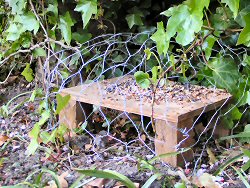 Ground-feeding platform protected with chicken wire.
Many garden birdwatchers, myself included, like to put some foods like soft fruit on the ground for birds such as thrushes which are less inclined to feed from tables or feeders. Try not to do this excessively and don't always put it in the same place: being unpredictable lessens the chance of a cat developing a hunting strategy. If you have a cat problem, then Ground-feeding platform protected with chicken wire.
Many garden birdwatchers, myself included, like to put some foods like soft fruit on the ground for birds such as thrushes which are less inclined to feed from tables or feeders. Try not to do this excessively and don't always put it in the same place: being unpredictable lessens the chance of a cat developing a hunting strategy. If you have a cat problem, then  don't feed birds like house sparrows (Passer domesticus) from ground hoppers when a hanging feeder will serve them just as well don't feed birds like house sparrows (Passer domesticus) from ground hoppers when a hanging feeder will serve them just as well don't feed birds like house sparrows (Passer domesticus) from ground hoppers when a hanging feeder will serve them just as well. If you do use a ground feeder, then you can cover it with chicken wire to keep visiting birds and small mammals safer from cats. don't feed birds like house sparrows (Passer domesticus) from ground hoppers when a hanging feeder will serve them just as well. If you do use a ground feeder, then you can cover it with chicken wire to keep visiting birds and small mammals safer from cats.
Position nest boxes and feeders in such a way that cats cannot easily find a position from which to launch an effective ambush. Place them far enough away from low cover to deter cats, but close enough to some cover (particularly higher foliage) to give birds a fighting chance of avoiding sparrowhawks (Accipter nisus) if you are lucky enough to have them visit. Make sure that nestboxes are not positioned where cats can sit and intimidate the birds, even if they cannot easily reach the box itself.
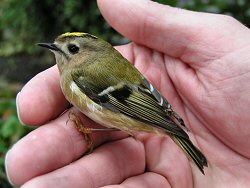 This goldcrest (Regulus regulus) hit a window on my house. Fortunately I caught it as it fell. After about five minutes it recovered and flew away. It could have been very different story if my cat had been there instead of me!
By planting prickly shrubs like holly (Ilex aquifolium), blackthorn (Prunus spinosa), hawthorn (Crataegus monogyna) and barberry (Berberris thunbergii), you can provide a living and virtually impenetrable (for cats) nesting habitat for many birds which will be much more secure than a leylandii hedge. You can place clippings from the same plants underneath bird tables or hanging feeders (or on top of nestboxes) to discourage cats (and even grey squirrels [Sciurus carolinensis]) from approaching too closely. If cats (and again grey squirrels) find it too easy to shin up a pole supporting a bird table or hanging feeder, then you can create a 'baffle', e.g. from a cut plastic drinks bottle, to put around the pole and make it harder to scale. This goldcrest (Regulus regulus) hit a window on my house. Fortunately I caught it as it fell. After about five minutes it recovered and flew away. It could have been very different story if my cat had been there instead of me!
By planting prickly shrubs like holly (Ilex aquifolium), blackthorn (Prunus spinosa), hawthorn (Crataegus monogyna) and barberry (Berberris thunbergii), you can provide a living and virtually impenetrable (for cats) nesting habitat for many birds which will be much more secure than a leylandii hedge. You can place clippings from the same plants underneath bird tables or hanging feeders (or on top of nestboxes) to discourage cats (and even grey squirrels [Sciurus carolinensis]) from approaching too closely. If cats (and again grey squirrels) find it too easy to shin up a pole supporting a bird table or hanging feeder, then you can create a 'baffle', e.g. from a cut plastic drinks bottle, to put around the pole and make it harder to scale.
 I am convinced that a large number of birds 'taken' by cats are primarily victims of window strikes I am convinced that a large number of birds 'taken' by cats are primarily victims of window strikes I am convinced that a large number of birds 'taken' by cats are primarily victims of window strikes. During the summer months in particular, when there are a lot of young and inexperienced birds around, I have often seen or heard a bird fly into one of the windows on my house. Once we even had a window strike by a kingfisher (Alcedo atthis), even though there is no running water anywhere near my garden. More often than not, the bird is only dazed and eventually recovers and flies away. But how often must these dazed birds be found by a cat before they have a chance to fully recover? By reducing the chances of window strikes, we could probably do a fair bit to reduce 'predation' of cats on birds. You can place stickers on windows or keep curtains drawn where practicable. Stickers in the shape of bird silhouettes or spider's webs are available from many wildlife garden suppliers (but they are not cheap if you have a large number of windows to do). I am convinced that a large number of birds 'taken' by cats are primarily victims of window strikes. During the summer months in particular, when there are a lot of young and inexperienced birds around, I have often seen or heard a bird fly into one of the windows on my house. Once we even had a window strike by a kingfisher (Alcedo atthis), even though there is no running water anywhere near my garden. More often than not, the bird is only dazed and eventually recovers and flies away. But how often must these dazed birds be found by a cat before they have a chance to fully recover? By reducing the chances of window strikes, we could probably do a fair bit to reduce 'predation' of cats on birds. You can place stickers on windows or keep curtains drawn where practicable. Stickers in the shape of bird silhouettes or spider's webs are available from many wildlife garden suppliers (but they are not cheap if you have a large number of windows to do).
Reducing effectiveness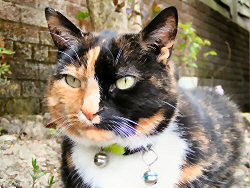 Clarry wearing a collar with two bells Clarry wearing a collar with two bells
- Make sure your cat wears a collar with a bell (preferably two bells).
- Consider fitting a collar with a sonic device.
- Attract as many birds as possible to the garden.
 Making sure that your cat never goes out without a collar sporting a bell will help to make it a less effective hunter Making sure that your cat never goes out without a collar sporting a bell will help to make it a less effective hunter Making sure that your cat never goes out without a collar sporting a bell will help to make it a less effective hunter. I like my cat to wear a collar with two bells because a cat can learn to keep a single bell quiet, but it is much harder to silence two. You can buy electronic sonic devices for cat collars, which are also effective at reducing predation. Research by the RSPB has shown that cats wearing bells caught 41% fewer birds and 34% fewer mammals than those with nothing on their collar. Cats wearing sonic devices caught 51% fewer birds and 38% fewer mammals compared with cats with nothing on their collar. (See news item for 13th June 2005.) So the sonic devices were found to be a bit more effective, but at around £20 a shot, they are much more expensive - particularly if your cat, like mine, is apt to lose its collar from time to time! The good news is that Making sure that your cat never goes out without a collar sporting a bell will help to make it a less effective hunter. I like my cat to wear a collar with two bells because a cat can learn to keep a single bell quiet, but it is much harder to silence two. You can buy electronic sonic devices for cat collars, which are also effective at reducing predation. Research by the RSPB has shown that cats wearing bells caught 41% fewer birds and 34% fewer mammals than those with nothing on their collar. Cats wearing sonic devices caught 51% fewer birds and 38% fewer mammals compared with cats with nothing on their collar. (See news item for 13th June 2005.) So the sonic devices were found to be a bit more effective, but at around £20 a shot, they are much more expensive - particularly if your cat, like mine, is apt to lose its collar from time to time! The good news is that  the good old-fashioned (and cheap) bell is very effective at reducing predation the good old-fashioned (and cheap) bell is very effective at reducing predation the good old-fashioned (and cheap) bell is very effective at reducing predation. the good old-fashioned (and cheap) bell is very effective at reducing predation.
Rather counter-intuitively,  the mammal society research found that cats tended to catch fewer birds in gardens that attracted more birds the mammal society research found that cats tended to catch fewer birds in gardens that attracted more birds the mammal society research found that cats tended to catch fewer birds in gardens that attracted more birds. This is thought to be because of 'collective vigilance'; a phenomenon where animals become more effectively vigilant against predators in larger groups. The more birds there are, the more likely a cat is to be seen. Have you ever heard blackbirds (Turdus merula) or robins scolding a cat in the garden? Rest assured, the rest of the birds in your garden have heard them too - they work cooperatively to reduce the risk of the cat taking any bird. This is welcome news if you have ever been troubled by the argument that it is unfair to attract birds to your garden if you own a cat. In fact by attracting birds to your garden, you will likely reduce the predatory effects of your cat. the mammal society research found that cats tended to catch fewer birds in gardens that attracted more birds. This is thought to be because of 'collective vigilance'; a phenomenon where animals become more effectively vigilant against predators in larger groups. The more birds there are, the more likely a cat is to be seen. Have you ever heard blackbirds (Turdus merula) or robins scolding a cat in the garden? Rest assured, the rest of the birds in your garden have heard them too - they work cooperatively to reduce the risk of the cat taking any bird. This is welcome news if you have ever been troubled by the argument that it is unfair to attract birds to your garden if you own a cat. In fact by attracting birds to your garden, you will likely reduce the predatory effects of your cat.
Be imaginative
I have tried to cover the most commonly recommended steps for reducing the predatory effects of cats on wildlife, but the list is not exhaustive. As I have already said,  every situation, and every cat, needs to be considered as a unique case every situation, and every cat, needs to be considered as a unique case every situation, and every cat, needs to be considered as a unique case. Not all of the steps outlined here are likely to be appropriate in your own case. Conversely, you may want to try something which isn't suggested. When I had a problem with my cat intimidating house martins (Delichon urbica) by sitting on a window ledge in my bedroom and staring at the birds as they flew up to inspect the eaves, I decided to create a 'cat baffle' out of a plank of wood to prevent her settling on that window ledge. Unique problems may require unique solutions - don't be afraid to try something different or a bit wacky! every situation, and every cat, needs to be considered as a unique case. Not all of the steps outlined here are likely to be appropriate in your own case. Conversely, you may want to try something which isn't suggested. When I had a problem with my cat intimidating house martins (Delichon urbica) by sitting on a window ledge in my bedroom and staring at the birds as they flew up to inspect the eaves, I decided to create a 'cat baffle' out of a plank of wood to prevent her settling on that window ledge. Unique problems may require unique solutions - don't be afraid to try something different or a bit wacky!
| First published May 2005. Last revised June 2005. | |
Copyright Richard Burkmar 2005. Permission is hereby granted for anyone to use this article for non-commercial purposes which are of benefit to the natural environment as long the original author is credited. School pupils, students, teachers and educators are invited to use the article freely. Use for commercial purposes is prohibited unless permission is obtained from the copyright holder. |
Back to home page
Do you live in Merseyside? Interested in its wildlife? | |